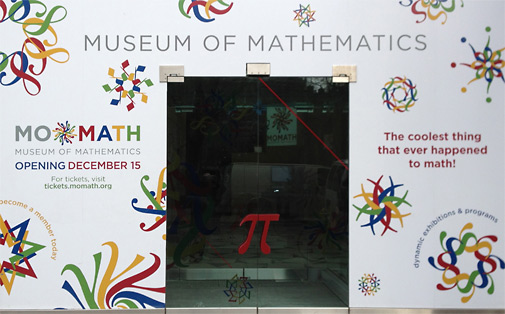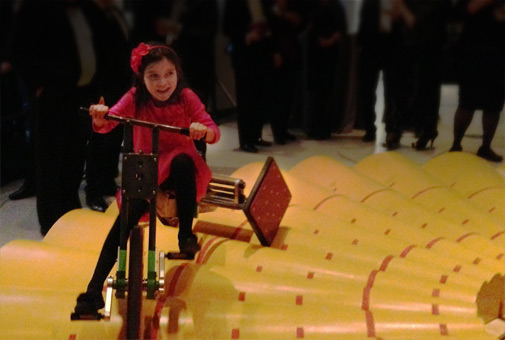I was just in New York City for the grand opening of the National Museum of Mathematics. Yes, there is now a National Museum of Mathematics, right in downtown Manhattan. And it’s really good—a unique and wonderful place. Which I’m pleased to say I’ve been able to help in various ways in bringing into existence over the past 3 years.

Of all companies, ours is probably the one that has been most involved in bringing math to the world (Mathematica, Wolfram|Alpha, Wolfram Demonstrations Project, MathWorld, Computer-Based Math, Wolfram Foundation, …). And for a long time I’ve thought how nice it would be if there were a substantial, physical, “museum of mathematics” somewhere. But until recently I’d sort of assumed that if such a thing were going to exist, I’d have to be the one to make it happen.
A little more than 3 years ago, though, my older daughter picked out of my mail a curious folding geometrical object—which turned out to be an invitation to an event about the creation of a museum of mathematics. At first, it wasn’t clear what kind of museum this was supposed to be. But as soon as we arrived at the event, it started to be much clearer: this was “math as physical experience”. With the centerpiece of the event, for example, being a square-wheeled tricycle that one could ride on a cycloidal “road”—a mathematical possibility that, as it happens, was the subject of some early Mathematica demonstrations.
Behind the museum was a small group led by Glen Whitney, an energetic math PhD and recently “retired” hedge fund quant, who I had never met, but with whom I turned out to have quite a few connections in common. Soon I was involved as a trustee of the fledgling museum, and four other people from our company were on its advisory council. Needless to say, there were many questions and issues. But a prominent early one was what the logo for the museum should be.
What iconic image would best capture mathematics and its character, and be lively enough to connect with the youthful target group for the museum? Our company has had a strong graphic design tradition, and is of course deeply involved in math. So it was natural for me to suggest that perhaps we could make an early contribution to the museum by trying to develop a logo.
I posed the problem at our company, and quickly got a response from Chris Carlson in our User Interfaces group. Chris has been at our company for more than 18 years, and has long had an interest in computable forms (and in fact his PhD in architecture from Carnegie Mellon was on this subject). So perhaps it was not surprising that Chris suggested not just a logo, but a computable “meta-logo”—an infinite family of possible logos, generated by simple rules.
His idea was ultimately quite simple: pick a mathematical symbol and apply a sequence of symmetry transformations to it. But as is so often the case with simple rules, the results can be elaborate and striking:

His original proposal, developed with members of our Design group (including our longtime art director Jeremy Davis) addressed some of the new possibilities—and issues—presented by the meta-logo. The museum didn’t have to have a single official logo; it could have logos created all the time by its visitors. And the logos didn’t have to be static; they could animate too. Different projects or events could have their own special logos. And the logo itself could serve as a simple puzzle (“what symbol is that?”). And so on. Of course there were issues too. Like would a meta-logo, with its infinite variations, still be recognizable?
But after some discussion at the museum, the decision was made that, yes, the meta-logo was going to work. And indeed its very variability and structure seemed to capture remarkably well some of the most important features of mathematics. Gradually all sorts of lovely possibilities emerged for how a mass-customizable meta-logo could be deployed—from personalized business cards for the staff, to “logo IDs” for visitors, to being able to decorate almost anything with multiple variations of the logo.
And almost three years later there I was a few days ago walking down 26th St. from Fifth Avenue in New York, and I look up to see:

I reach the museum, and of course the (temporary) main entrance is full of logos:

It’s a few hours before the opening gala event. And of course inside it’s a hive of activity. The first thing I see is the logo generator station for visitors. But oops… there are no logos there yet, just lots of Mathematica code on the screen:

A basic interactive system for generating logos is a tiny amount of Mathematica code. But getting everything exactly right turns out to be quite tricky, and to involve some quite sophisticated mathematics. It’s easy to apply symmetry operations to regions representing font characters. The issue is rendering them. The most obvious thing is to layer them in the order they’re generated. But if the regions overlap, then doing that can break symmetry. And the only way to guarantee to preserve symmetry is to do some intricate computational geometry, breaking up the regions just right.
And with hours to spare, the final touches were finished, and the logo generator was ready. And so was the rest of the museum.

It’s an impressive two floors of exhibits. Full of inventive ideas about how to make math tangible to all, from middle school (or below) on. I’m quite a connoisseur of both mathematics and museums. But what impresses me most about MoMath is how different its exhibits are from what I’ve seen before. Each one has a unique idea. That I’ve typically never seen before. But that elegantly illustrates some fundamental mathematical principle. And does it in a way that only a physical exhibit can. Like nesting in the “human tree”:

Often there are computers involved in the exhibits. But they’re controlled and used in very physical ways—that makes it clear why this has to be a physical museum, not some kind of virtual entity on the web. To me, it’s also very cool that most of the exhibits can be understood at several levels. There’s the basic math that’s being illustrated. And then there’s the “how does that actually work?”, and the “how does one build something to do this?”. Like the non-holographic 3D images (that can’t be captured in a photograph):

It wasn’t cheap to make the museum. And to me it’s impressive how much money was raised for the cause of math. To be able to put the museum in the center of Manhattan, and to create such beautifully made exhibits, with elegantly machined pieces—that are nevertheless designed to be tough enough to withstand the onslaught of young users.
When I was a toddler (long, long ago!) I was fortunate enough to live near the Science Museum in London. Which at the time was just opening its first hands-on gallery. That I insisted on being taken to visit almost every day for a whole summer.
I don’t know what my early experiences with those exhibits imprinted on me. But it’s remarkable to see—half a century later—how the advance of technology and all the creativity that’s been put into MoMath has led to such vastly richer exhibits.
In the coming days and weeks, lots of kids—and adults—will get their first taste of the first national museum of mathematics ever to exist in the US. No doubt MoMath will become quite a destination for students, tourists—and, I suspect, events of all sorts. People will learn a lot—and have fun. And remember for a long time their ride on the square-wheeled tricycle—much as I still remember a ride I had on a Galapagos tortoise at the London Zoo nearly 50 years ago. (At the MoMath gala, my younger daughter happened to be captured moments after this picture by a photographer from The Wall Street Journal…)

There could have been a National Museum of Mathematics in the US long long ago. But there wasn’t. And it’s only now, through the remarkable efforts of a small number of people, that MoMath exists. It’s going to be a great institution, and it’s one more step in the effort that we’ve been so involved with to bring the heritage and promise of mathematics to the 21st century.


